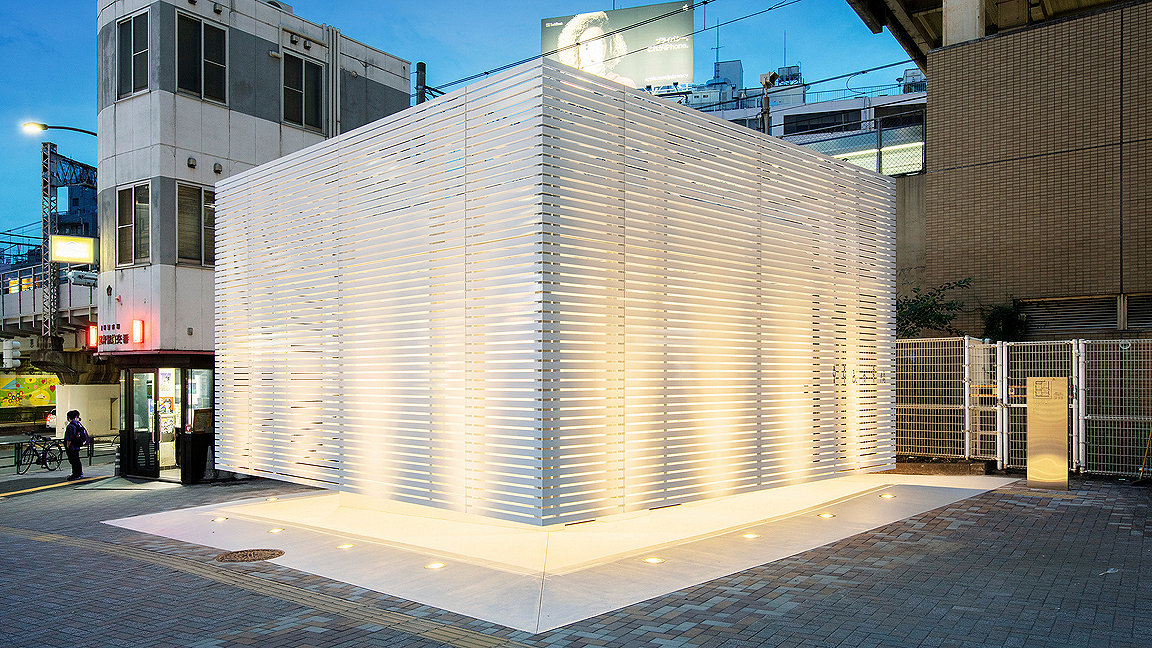
The Tokyo Toilet by SAMURAI. Photo: Satoshi Nagare, provided by The Nippon Foundation
In March, stories of a London theatre’s gender-neutral toilet, where women file past men at five urinals to use one single cubicle, whipped up a media headline frenzy about making women feel uncomfortable when going to the loo.
While the Lyric Hammersmith stated it wants to “meet the needs of all the individuals who use our building,” the story highlighted how some companies and local authorities are navigating the growing need, and call, for unisex toilets to cater for everyone.
It also shone a light on the importance of toilets. One of life’s common denominators, no matter who you are, is the need go to the toilet. Having access to conveniences outside the home, whether in shopping centres, five-star hotels, city-centre restaurants, pubs, or council-run public facilities, is crucial.
So, in public or in private development, how important is the water closet? And how much does practicality compete with pretty when it comes to toilet design?
Since joining the British Toilet Association two decades ago and rising to become the organisation’s MD, Raymond Martin has been a passionate campaigner for improvements to toilets in every establishment. “Toilets are not about waste management, they’re about health and wellbeing,” says Martin. “We must eat, drink, sleep, breathe and go to the toilet: those five things are not negotiable. Those are things we must do.”
In 2019, UNICEF stated that 60% of the world’s population does not have a toilet at home or one that doesn’t safely manage human waste.
“We must eat, drink, sleep, breathe and go to the toilet: those five things are not negotiable” Raymond Martin, British Toilet Association
What makes a good toilet?
When it comes to the debate on pretty versus practical for toilet design, Martin says he doesn’t care how a toilet looks. “The best toilet is one that works. If it’s clean, hygienic, with hot water, soap, and the toilet flushes – that’s a good toilet.
“It doesn’t matter about the colour of the wallpaper, that it’s got flashy lights, music playing: if the door locks, you’ve got privacy, and feel safe and secure, that’s a good toilet and you get relief.”
Sometimes the design can be overcomplicated, agrees Romulus Sim, architect associate at BDP. But he says, it depends on who the toilets are for. “If you’re designing for a very specific client fitout such as Google, they might want a funky toilet,” says Sim. “But it might also be a more run-of-the-mill office where it’ll be functional.” Public buildings, like a museum, or gallery, will have a different feel to a children’s play centre, with a different approach, and style.
The UK’s largest pub chain, JD Wetherspoons, is a regular winner of the Loo of the Year awards. Its many bathrooms are individually designed to have a “quality look and feel to them, with architects choosing the colour schemes relevant to the pub design,” says the pub group’s spokesperson Eddie Gershon.
“We like them to be spacious and have natural light where we can. They have lobbies wherever possible to maintain privacy for customers, and a separate ante-room area is provided in the ladies toilets,” Gershon adds.
Styling stations are becoming the latest trend for toilets. “We are designing more of them, for people getting ready for a night out,” says Dan Gardner, senior workplace strategist at KKS Savills.
Since COVID-19, hygiene has been heightened with a push for more touch-free design for lights and hand basins. They should be positioned by the dryers to prevent water dripping leading to wet floors.
A patron of the privy
Space also matters. “One of the biggest mistakes is making the ladies’ and mens’ toilet the same square footage. That is wrong, as the ladies’ need to be bigger with more cubicles so that they don’t have to queue for toilets,” says Jack Sim, founder of the World Toilet Organisation (WTO).
A graduate of the Singapore Institute of Surveyor and Valuers, Sim established the WTO on 19 November 2001 – that date has been adopted by the UN and all its 193 members as World Toilet Day. “The whole idea is that the subject is neglected, and it is considered embarrassing, so somebody has to make it palatable,” he says.
Sim adds that lighting should not be behind the head when washing, so people can see properly what they are doing, and toilets should have good ventilation. And while internal toilet design is open to interpretation, the actual position of toilets within a building should start at the earliest possible stage.
“Toilets have to be thought of first,” agrees BDP’s Romulus Sim. “These are facilities that need to go into the building: stairs, fire escapes, toilets, then everything else around it.”
Where they are depends on the type of space and building. For office developments it’s the core, and in hospitals it’s close to waiting areas, where people would congregate. “In shopping centres, they’re okay to be tucked away because the prime real estate are shops,” says BDP’s Sim. “The toilets need to be positioned strategically, but they can’t take centre stage. At the same time, you need to sign post people to them effectively.”
When the toilet facilities at the 11-year-old London’s Westfield Stratford City undergo a refurbishment in Q1 2024, owners Unibail-Rodamco-Westfield, are set to follow the trends of inclusivity. As well as putting baby changing tables in male toilets, the spokesperson adds: “We have addressed the issue of access to WCs that are not gender specific – there are four individual cubicles that are open to all.”
Gender neutral toilets
In the last few years, the call for gender neutral toilets, that can be used by male, female, trans and non-binary users, has got louder. This prompted the UK government to state in July last year that new public buildings must have separate male and female toilets.
This doesn’t, however, apply to private buildings. For many companies the subject is sensitive with internal diversity and inclusion strategies leading the conversation. Clients are thinking more broadly about the specifics of who is going to be using toilets, says Yetta Reardon Smith, KKS Savills workplace strategy team lead.
For a commercial development, toilets are among the most important parts to consider. “They bring tourists, visitors, footfall – people will shop with their feet when they are thinking about where they will go to the loo,” says Martin.
Chris Igwe, global retail adviser, says: “They are spaces where you are totally alone, using a urinal or going to the toilet. There’s a huge importance on the value of time for yourself because culturally in the Western world, we don’t take that time. It could be a minute, generally it’s five minutes, it’s a space that’s personal.
“And if I can do it within a nice environment, in a toilet, then for me that’s an added value.”
“They have lobbies wherever possible to maintain privacy for customers, and a separate ante-room area is provided in the ladies toilets” Eddie Gershon, JD Wetherspoon
The Ladies Sanitary Association
We may think nothing of stopping at a public toilet now to ‘spend a penny’ but it’s not always been such a simple act. When public toilets first started to become a common sight in the mid-1800s, the vast majority of them were built to serve men only. This meant women could not travel much further than their home or homes of friends and family because of what became known in the UK as ‘the urinary leash’.
The Ladies Sanitary Association was formed in Britain to campaign for better access to public toilets for women. One of their best-known champions was playwright George Bernard Shaw who campaigned for women to have a public convenience in Camden. This met resistance though – opponents of womens’ public toilets paid hansom cab (a horse-drawn taxi) drivers to deliberately collide with the proposed Camden site to demonstrate how much it would get in the way.
In other instances, opponents of womens’ public toilets complained that such buildings would bring nearby house prices down or that ‘modest’ women should not wish to be seen entering a public toilet. However when the First World War began in 1914, and women began to enter previously male-dominated workplaces such as munitions factories, employers were compelled to provide adequate facilities.

